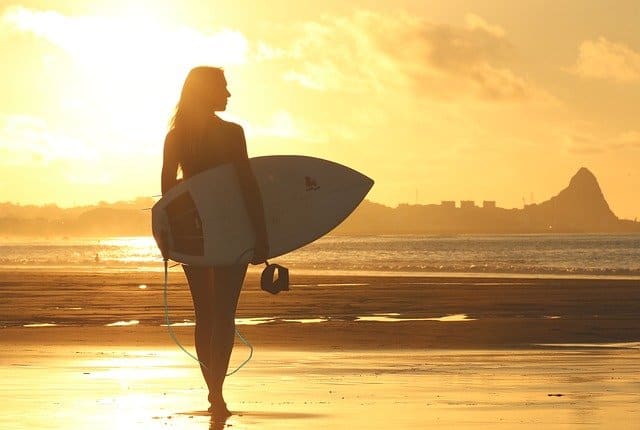Slacklining requires good balance and so does surfing. So, does practicing slacklining help you become a better surfer or vice versa?
Balance is an important aspect for both slacklining and surfing as is determination, concentration and flexibility but becoming a good surfer also requires timing, strength, paddling and ability to read the waves which slacklining does not.
Having said that, slacklining does work on several skills that can come in handy not only for better slacklining but surfing and other activities.
Slacklining helps you improve your:
- Balance
- Concentration
- Coordination
- Stabilization of muscles
- Determination
- Flexibility
So maybe a better question would be….
Does surfing help slacklining?
Given the number of skills that surfing requires, surfing might help to improve several skills required by slackliners. Surfing is a multi-disciplinary activity requiring focused efforts on a number of skills and traits.
Surfing helps improve your:
- Balance
- Concentration
- Coordination
- Stabilization of muscles
- Determination
- Flexibility
- Timing
- Strength
- Paddling
- Ability to read the waves
Having said all that, the main skills you see are relevant to both activities are the top six ones shown above which are namely balance, concentration, coordination, stabilization of muscles, determination and flexibility.
Balance
There’s a difference between balancing on a 1″ or 2″ wide slackline and a surfboard that can be between 20½” and 22¼” wide. But then again each activity brings its own unique set of challenges regarding balance:
Dealing with slackness and tension of a slackline and water and waves when surfing. Plus you’re standing on a slackline that is more narrow than your feet.
A new slackliner will undoubtedly face the uphill battle of balancing themselves on the slackline once they’ve managed to climb on in the first place whereas a surfer needs to be able to stand up on a surfboard once they catch a wave.
Concentration
Concentration is required for both balancing and walking on a slackline and standing up and remaining upright on a surfboard. Over time, you’ll learn with both activities how to concentrate on the goal:
With slacklining, it’s aiming for the end of the slackline that you’re walking towards whereas on a surfboard it’s remaining upright on the board.
Coordination
Both slacklining and surfing require coordination. While some people are naturally better coordinated that others, it is a skill that can be worked on and improved upon and both activities can assist in that regard.
Stabilization of muscles
Climbing onto the slackline and standing up on a surfboard are very difficult tasks that generally aren’t accomplished by either new slackliners or surfers on the first attempt.
Or even the first day for that matter.
Research has shown that the phenomenon that slackliners face when they try to climb on the line while the line shakes and swings can dissipate over time with practice. While you can also reduce sway with a slightly tighter slackline and use of a top rope while you’re getting your balance, practice can make perfect.
Over time with repeated attempts you will be able to more easily climb on the slackline with your dominant leg without dealing with the uncontrollable sway of the line.
Determination
Both slacklining and surfing require determination. They tend not to be activities that you will master quickly. Your skillset in each of the traits mentioned in the above lists will go a long way to determining your success or lack thereof.
But your determination – your ability to fall down (literally) and get back up – is key too.
Flexibility
Your legs, knees and ankle joints play a big part of the success you will have as a slackliner. The more flexible you are, the quicker and more safely you can react to losing your balance without pulling a muscle.
Surfers in some respects need even more flexibility because they climb on their board and paddle out against the waves, then quickly rise up and stand on their board to gain their balance. They stand with flexed knees fighting the waves and will inevitably hit the water hard on occasion when they lose their balance.
Not only are you bending your knees in both activities, but you are fighting to maintain your balance while trying not to injure yourself in the process by pulling a muscle or straining yourself one way or the other.
Summary
So does slacklining help surfing or does surfing help slacklining?
We can probably agree that it could potentially be a bit of both. Both activities do require a number of common traits including balance, concentration, coordination, stabilization of muscles, determination and flexibility.
You will improve these skills over time and maybe even improve a few other ones along the way as you begin to master the slackline.
Recent Posts
Slacklining is a challenging activity that involves walking, balancing, and performing tricks on a flat piece of webbing stretched between two anchor points. It has become increasingly popular in...
Slacklining is a fun and challenging way to improve your balance, core strength, and overall fitness. Whether you're new to slacklining or a seasoned pro, incorporating a slackline workout routine...


